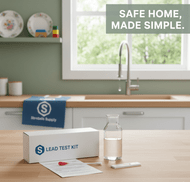The Best Lead Testing Kits for Home Use in 2025
Sep 15th 2025
The Best Lead Testing Kits for Home Use in 2025
Lead exposure is still a real risk especially in homes built before 1978, on painted surfaces, vintage dishware, toys, and sometimes in drinking water from old plumbing. This guide explains which at-home lead test kits make sense, what “EPA-recognized” actually means, how accurate DIY kits are, and when you should use lab testing or a certified professional. We keep it clear, practical, and family-safe.
Why Test for Lead at Home?
Lead is a toxic metal found in:
-
Paint: Common in homes built before 1978, especially on walls, windows, or furniture.
-
Drinking Water: From old pipes, solder, or fixtures.
-
Household Items: Toys, ceramics, jewelry, or dishes.
Exposure can cause serious health issues, like developmental delays in kids or organ damage in adults. Lead testing kits provide fast results—often in 30 seconds to 5 minutes—so you can identify risks and act quickly. Whether you’re renovating, checking your tap water, or screening vintage items, testing is the first step to a safer home.
What Can You Test with a Lead Testing Kit?
Different kits target different sources:
-
Paint and Surfaces: Swab kits detect lead on painted walls, doors, or furniture, ideal before sanding or remodeling.
-
Household Items: Some kits screen ceramics, toys, or jewelry for surface lead (not how much might leach).
-
Drinking Water: Water kits measure dissolved lead in parts per billion (PPB), with thresholds like 5-15 PPB aligned with EPA standards.
Choose the right kit for your needs: surface swabs for paint, water kits for taps or wells, or lab services for detailed analysis.
What Does “EPA-Recognized” Mean?
The U.S. Environmental Protection Agency (EPA) approves certain kits, like LeadCheck™ and D-Lead®, for detecting lead in paint under the Renovation, Repair, and Painting (RRP) Rule. These kits meet strict performance criteria for negative results (confirming no lead). However, only trained professionals can use them for regulatory compliance, like during renovations.
For homeowners, EPA-recognized kits are reliable for DIY screening before small projects. For official needs (e.g., real estate or clearance), hire a certified inspector or send samples to an accredited lab. At Strobels Supply, we stock EPA-recognized kits for trustworthy results.
Comparing Lead Testing Kits
Here’s a quick guide to the main types of lead testing kits:
|
Kit Type |
Use For |
Pros |
Cons |
|---|---|---|---|
|
Paint Surface Swabs |
Painted walls, doors, furniture |
Fast (30 seconds), affordable ($10-20), easy to use |
Technique-sensitive, may miss deeper layers, yes/no results |
|
UV/Fluorescence Kits |
Surfaces like paint, ceramics, toys |
High sensitivity, visual results under UV light |
Binary (not quantitative), not for water/soil |
|
Drinking Water Kits |
Tap or well water |
Detects 4-15 PPB, 5-10 minute results, EPA-aligned |
Single-sample test, confirm positives with lab |
|
Lab Services |
Paint, dust, water confirmation |
Quantitative, defensible reports |
Slower, more expensive ($50+) |
At Strobels Supply, we offer surface swabs and water kits to cover most home testing needs, starting at $34.55.
Are Home Lead Testing Kits Accurate?
Yes, when used correctly:
-
Surface Kits: EPA-recognized kits (e.g., LeadCheck™, D-Lead®) are reliable for negative results. False negatives can occur if you don’t reach older paint layers or follow instructions. Wirecutter notes newer UV methods (e.g., Lumetallix) may be more sensitive but aren’t yet EPA-recognized.
-
Water Kits: Kits like our DIY Lead in Drinking Water Test Kit detect lead as low as 4 PPB, validated by EPA-certified labs. They’re accurate for screening but should be confirmed with lab testing for medical or remediation decisions.
Tips for Accuracy:
-
Prep surfaces by cleaning dust.
-
Follow timing (e.g., 30 seconds for swabs).
-
Use fresh reagents and check expiration dates.
How to Test for Lead Safely
Follow these steps for accurate, safe testing:
-
Choose the Right Kit: Use surface swabs for paint or items, water kits for taps/wells.
-
Prepare: Wear gloves, lay plastic sheeting for micro-samples, keep kids/pets away.
-
Test: For surfaces, rub a swab (often vinegar-activated) for 30 seconds. For water, collect a sample and add a strip or reagent.
-
Read Results: Check for color changes (e.g., red/pink for lead) or PPB ranges (0-4, 5-15, 15+ PPB). Photograph results for records.
-
Act on Positives: Avoid disturbing surfaces, isolate items, and consult a certified professional or lab for confirmation.
Note: Each kit includes manufacturer instructions. Always follow those directions carefully for best results.
Common Questions About Lead Testing Kits
Can White Vinegar Test for Lead?
No. Vinegar isn’t a lead detector. Use a validated kit; some swabs are activated with vinegar but rely on specific reagents to detect lead.
Are Home Test Kits for Lead Accurate?
Yes, EPA-recognized kits are accurate for screening, especially for negative results. Water kits with 4-10 PPB detection are lab-validated. Follow instructions to avoid errors, and confirm positives with a lab for critical decisions.
Can You Test Yourself for Lead at Home?
Absolutely! Our EPA-recognized Lead Testing Kits are designed for DIY use. They’re easy to use for paint, water, or items like toys, with results in 30 seconds to 5 minutes.
Do I need different kits for paint and water?
Yes. Surface kits are for paint and solid items; water kits detect dissolved lead in drinking water.
When Should I Hire a Professional?
Hire a certified inspector or lab for:
-
Renovations in pre-1978 homes.
-
Positive or unclear test results.
-
Official documentation for real estate or compliance.
Your Shopping Checklist
Before buying a lead testing kit, check for:
-
Purpose: Matches your need (paint, water, or both).
-
Sensitivity: Surface kits with clear indicators; water kits detecting 4-15 PPB.
-
Validation: EPA recognition (paint) or lab validation (water).
-
Ease of Use: Clear instructions, customer support, fresh reagents.
-
Safety Gear: Gloves, plastic sheeting, or a P100 respirator for renovations.

 US Dollars
US Dollars
